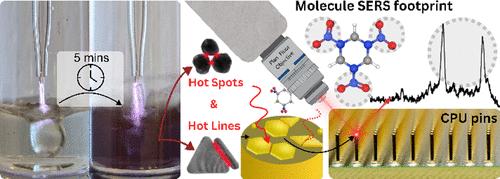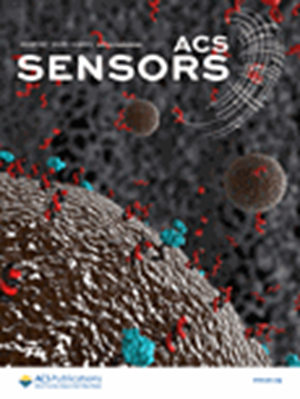Microplasma Controlled Nanogold Sensor for SERS of Aliphatic and Aromatic Explosives with PCA-KNN Recognition
IF 9.1
1区 化学
Q1 CHEMISTRY, ANALYTICAL
引用次数: 0
Abstract
Nanogold is an emerging material for enhancing surface-enhanced Raman scattering (SERS), which enables the detection of hazardous analytes at trace levels. This study presents a simple, single-step plasma synthesis method to control the size and yield of Au nanoparticles by using plasma-liquid redox chemistry. The pin-based argon plasma reduces the Au3+ precursor in under 5 min, synthesizing Au spherical particles ranging from ∼20 nm at 0.025 mM to ∼90 nm at 1.0 mM, in addition to plate-like particles occurring at concentrations of 0.25–1.0 mM. The enhanced SERS responses correlated with the UV–vis absorption and reflectance profiles, which can be attributed to synergistic plasmonic hotspots created by the sphere–sphere, plate-sphere, and plate–plate nanogold interactions. This nanogold mixture, combined with gold-plated CPU grid pin arrays, facilitated the detection of trace explosives, including aromatic (TNT, TNB, and TNP) and aliphatic (RDX, PETN, and HMX) compounds. We demonstrate that stabler aliphatic analytes, associated with lower vapor pressure (10–8–10–11 atm), exhibit smaller signal fluctuations (RSD ∼ 6–10%) compared to their more volatile (10–5 atm) aromatic (RSD ∼ 12–17%) counterparts at similar analyte concentrations. The calculated limit of detection (LoD) was found to be ∼2–6 nM and ∼600–900 pM for aromatic and aliphatic explosives, respectively. Finally, we show that the poorer performance of aromatic explosives under the same sensing conditions affects SERS-PCA separation, which can then be improved either by a machine learning approach (PCA with k-NN classification) or by consideration of a specific NO2 symmetric stretching fingerprint range.

基于PCA-KNN识别的脂肪族和芳香炸药SERS微等离子体控制纳米金传感器
纳米金是一种用于增强表面增强拉曼散射(SERS)的新兴材料,可以检测痕量有害分析物。本研究提出了一种简单的单步等离子体合成方法,利用等离子体-液体氧化还原化学来控制金纳米颗粒的大小和产率。引脚基氩等离子体在5分钟内降低了Au3+前体,合成了范围从0.025 mM ~ 20 nm到1.0 mM ~ 90 nm的Au球形颗粒,以及0.25-1.0 mM浓度的片状颗粒。增强的SERS响应与紫外-可见吸收和反射曲线相关,这可归因于球-球、板-球和板-板纳米金相互作用产生的协同等离子体热点。这种纳米金混合物与镀金CPU网格引脚阵列相结合,有助于检测痕量爆炸物,包括芳香(TNT、TNB和TNP)和脂肪族(RDX、PETN和HMX)化合物。我们证明,在相似的分析物浓度下,与挥发性更强(10-5 atm)的芳香物(RSD ~ 12-17%)相比,稳定的脂肪族分析物与较低的蒸气压(10-8-10-11 atm)相关,表现出更小的信号波动(RSD ~ 6-10%)。计算出的检测限(LoD)分别为~ 2 ~ 6 nM和~ 600 ~ 900 pM。最后,我们证明了芳香炸药在相同传感条件下较差的性能会影响SERS-PCA分离,然后可以通过机器学习方法(带有k-NN分类的PCA)或考虑特定的NO2对称拉伸指纹范围来改进SERS-PCA分离。
本文章由计算机程序翻译,如有差异,请以英文原文为准。
求助全文
约1分钟内获得全文
求助全文
来源期刊

ACS Sensors
Chemical Engineering-Bioengineering
CiteScore
14.50
自引率
3.40%
发文量
372
期刊介绍:
ACS Sensors is a peer-reviewed research journal that focuses on the dissemination of new and original knowledge in the field of sensor science, particularly those that selectively sense chemical or biological species or processes. The journal covers a broad range of topics, including but not limited to biosensors, chemical sensors, gas sensors, intracellular sensors, single molecule sensors, cell chips, and microfluidic devices. It aims to publish articles that address conceptual advances in sensing technology applicable to various types of analytes or application papers that report on the use of existing sensing concepts in new ways or for new analytes.
 求助内容:
求助内容: 应助结果提醒方式:
应助结果提醒方式:


